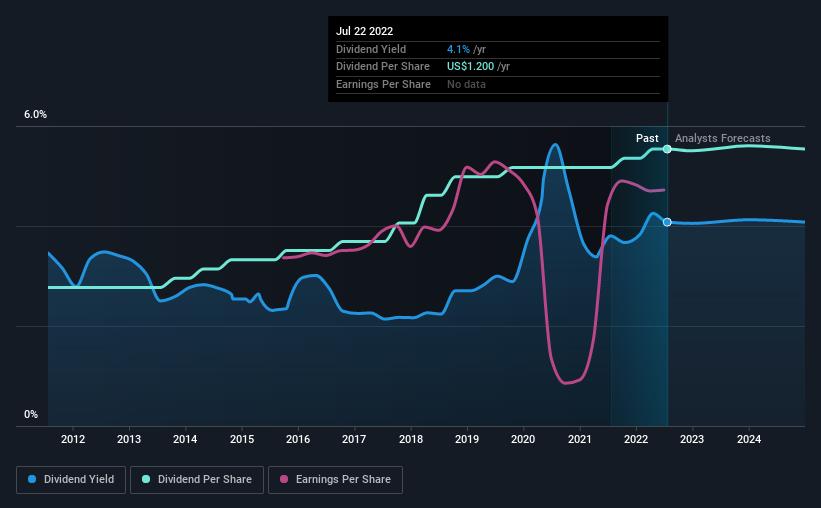- United States
- /
- Banks
- /
- NasdaqGS:STBA
S&T Bancorp (NASDAQ:STBA) Will Pay A Larger Dividend Than Last Year At $0.30

S&T Bancorp, Inc. (NASDAQ:STBA) has announced that it will be increasing its dividend from last year's comparable payment on the 18th of August to $0.30. This takes the dividend yield to 4.1%, which shareholders will be pleased with.
Check out our latest analysis for S&T Bancorp
S&T Bancorp's Payment Expected To Have Solid Earnings Coverage
While it is great to have a strong dividend yield, we should also consider whether the payment is sustainable.
S&T Bancorp has a long history of paying out dividends, with its current track record at a minimum of 10 years. Taking data from its last earnings report, calculating for the company's payout ratio shows 43%, which means that S&T Bancorp would be able to pay its last dividend without pressure on the balance sheet.
Looking forward, EPS is forecast to rise by 1.7% over the next 3 years. Analysts estimate the future payout ratio will be 42% over the same time period, which is in the range that makes us comfortable with the sustainability of the dividend.

S&T Bancorp Has A Solid Track Record
The company has an extended history of paying stable dividends. The dividend has gone from an annual total of $0.60 in 2012 to the most recent total annual payment of $1.20. This means that it has been growing its distributions at 7.2% per annum over that time. Dividends have grown at a reasonable rate over this period, and without any major cuts in the payment over time, we think this is an attractive combination as it provides a nice boost to shareholder returns.
The Dividend's Growth Prospects Are Limited
The company's investors will be pleased to have been receiving dividend income for some time. Earnings per share has been crawling upwards at 3.9% per year. Growth of 3.9% per annum is not particularly high, which might explain why the company is paying out a higher proportion of earnings. While this isn't necessarily a negative, it definitely signals that dividend growth could be constrained in the future unless earnings start to pick up again.
S&T Bancorp Looks Like A Great Dividend Stock
Overall, we think this could be an attractive income stock, and it is only getting better by paying a higher dividend this year. Distributions are quite easily covered by earnings, which are also being converted to cash flows. All in all, this checks a lot of the boxes we look for when choosing an income stock.
It's important to note that companies having a consistent dividend policy will generate greater investor confidence than those having an erratic one. Meanwhile, despite the importance of dividend payments, they are not the only factors our readers should know when assessing a company. For example, we've identified 2 warning signs for S&T Bancorp (1 makes us a bit uncomfortable!) that you should be aware of before investing. Is S&T Bancorp not quite the opportunity you were looking for? Why not check out our selection of top dividend stocks.
New: Manage All Your Stock Portfolios in One Place
We've created the ultimate portfolio companion for stock investors, and it's free.
• Connect an unlimited number of Portfolios and see your total in one currency
• Be alerted to new Warning Signs or Risks via email or mobile
• Track the Fair Value of your stocks
Have feedback on this article? Concerned about the content? Get in touch with us directly. Alternatively, email editorial-team (at) simplywallst.com.
This article by Simply Wall St is general in nature. We provide commentary based on historical data and analyst forecasts only using an unbiased methodology and our articles are not intended to be financial advice. It does not constitute a recommendation to buy or sell any stock, and does not take account of your objectives, or your financial situation. We aim to bring you long-term focused analysis driven by fundamental data. Note that our analysis may not factor in the latest price-sensitive company announcements or qualitative material. Simply Wall St has no position in any stocks mentioned.
About NasdaqGS:STBA
S&T Bancorp
Operates as the bank holding company for S&T Bank that provides retail and commercial banking products and services to consumer, commercial, and small business in Pennsylvania and Ohio.
Flawless balance sheet established dividend payer.
Market Insights
Community Narratives


